1-01-Translation Analysis
- 格式:doc
- 大小:56.00 KB
- 文档页数:3
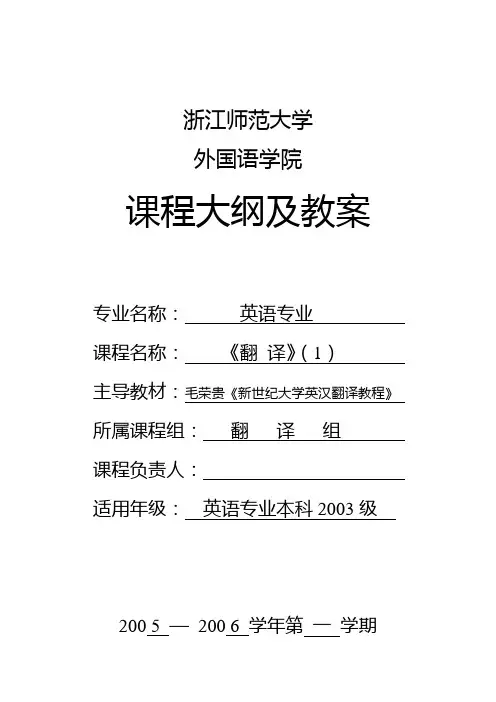
浙江师范大学外国语学院课程大纲及教案专业名称:英语专业课程名称:《翻译》(1)主导教材:毛荣贵《新世纪大学英汉翻译教程》所属课程组:翻译组课程负责人:适用年级:英语专业本科2003级200 5 —200 6 学年第一学期翻译(1)(2)课程大纲一、课程概况课程名称:翻译课程类别:专业基础课课程编号:030903081,030903082学分:4 学时:68 开课学期:五、六二、课程教学目标和要求1、[教学目标]通过本课程的教学,帮助学生有效提高翻译实践能力和理论认识,达到高等学校英语专业英语教学大纲对其翻译能力的基本要求,即:能运用翻译理论与技巧,将英美报刊上的文章以及文学原著译成汉语,或将我国报刊、杂志上的文章和一般文学作品译成英语,译文忠实、流畅,译速每小时250-300个英文单词汉字,使之可以胜任未来的中学英语教学以及其他涉及翻译能力的工作。
2、[课程要求]本课程为系列专业基础课,由英译汉和汉译英组成,要求学生按顺序修读。
为达到课程教学的目的,采用讲练结合的方式,布置相当数量的课后作业要求学生按时按量完成,并积极参与课堂讨论。
三、教学内容与教学安排1、[教学内容要点]本课程教学以实践为主,理论为辅,重点是翻译技巧的介绍与练笔,翻译内容涉及各类文体、各个领域。
课程安排按照讲练结合的原则展开,帮助学生有步骤有针对性地训练翻译的基本技能。
通过大量的练习和讲评,强化学生对不同文本语体特点和翻译原则的认识,为其将来从事翻译工作或运用英语作为工作语言打下坚实的双语转换实践基础。
2、[教学安排]本课程教学依据教学大纲,安排在本科三年级上、下两学期进行,共计68学时,其中36学时为英译汉,32学时为汉译英,每周2学时。
教学计划允许授课教师在具体操作中有一定的灵活度,但至少应包含以下3部分的主题内容:1)翻译概述(含翻译的标准、原则、过程、中外翻译简史及翻译名家的主要观点等);2)翻译技巧讲练(介绍主要的英汉互译技巧,结合学生的练笔进行讲评);3)多视角的翻译实践与研究(不同领域的翻译实践及其操作原则与技巧,如外来词翻译、报刊标题及新闻翻译、旅游翻译、科技翻译、广告翻译、文化与翻译等;在实践的基础上开始涉猎翻译的前沿理论,提高学生对翻译的理性认识,目的在于训练其解决问题的探索能力,为其将来从事翻译实践或理论研究开辟一个窗口)。

Chapter 1:Main issues of translation studies:1. Jacobson’s categories of translation:a. Intralingual;b. Interlingual;c. Intersemiotic (verbal- non-verbal).2.History of the discipline:a. From the late 18th to the 1960s – grammar-translation method (replaced by communicative approach in the 1960s and 1970s);b.The USA 1960s –translation workshop concept based on Richards’reading workshops and practical criticism approach that began in 1920s; running parallel to this approach was that of comparative literature;c.The USA 1930s-1960s/70s – contrastive analysis;d.More systematic, and mostly linguistic-oriented, approach 1950s-1960s:i.J.-P. Vinay and J. Darbelnet (French/English);ii. A. Malblanc (French/German);iii.G. Mounin (linguistic issues of translation);iv. E. Nida (based on Chomsky generative grammar).v.James S. Holmes’“The name and nature of translation studies”is considered to be the founding statement of a new discipline.vi.Hermans Manipulation Schoolvii.Vieira Brazilian cannibalist school Postcolonial theoryviii.Venuti cultural-studies-oriented analysisThe Holmes/Toury map of translation studies1:Chapter 2: Translation theory before the 20th century:Traduttore, traditore = the translator is a traitorChapter 3: Equivalence and equivalent effect:In the 1950s and 1960s the place of circular debates around literal and free translation took the new debate revolved around certain key linguistic issues, among them those of meaning and equivalence, discussed by R. Jakobson in 1959. Over the following 20 years many further attempts were made to define the nature of equivalence.Jakobson:1.Meaning: the signifier=the signal of the signified (the concept).2.There is no full equivalence between code-units of different languages.3.So, we should substitute not words, but messages.4.Only p oetry is considered ‘untranslatable’ and requires ‘creative transposition’.Nida’s ‘science of translating (subjective):1.Meaning:a.Linguistic;b.Referential (dictionary meaning);c.Emotive (connotative).2.Ways of determining meaning:a.Hierarchical structuring (animal dog, cow etc);ponential analysis (grandmother, mother, cousin etc);c.Semantic structure analysis (spirit can mean demon, angel, god, ghost, ethos, alcohol etc)meaning depending on context.3.3-stage system of translation (Chom sky’s influence: deep/surface structure of a language):SL1 (analysis) X (transfer) Y (restructuring) TL24.Equivalence:a.Formal (form and content);b.Dynamic (equivalent response of: t2 reader on t2 as t1 reader on t1) (closest naturalequivalent).5.Correspondence in meaning must have priority over correspondence in style.6.Reader-based orientation.主要理论1:对等和等效(1950s-1960s)1.代表人物(1)罗曼雅各布逊A.描写了翻译的三类型:语内翻译,语际翻译和符际翻译B.提出语际翻译指用一种语言替换另一种语言种的整个信息C.强调对等的差异性(2)尤金奈达A. 提出形式对等和动态对等B. 提出著名的读者反应理论C. 他的理论以乔姆斯基的转换生成语法为基础(3)皮特纽马克A.提出语义对等和交际对等(4)韦内科勒A.区分了对应和对等B.描写了五种对等:外延意义,隐含意义,文本规则,语用及形式对等Newmark’s semantic and communicative translation:1.Replaces Nida’s division with semantic (resembles formal equivalence) and communicative(resembles dynamic equivalence) translation.2.Nida’s division inoperant if the text is out of TL space and time.3.Dynamic equivalence: are readers ‘to be handed everything on a plate’?4.Semantic translation differs from literal in that it ‘respects context’, interp rets and explains(metaphors). Literal translation is to be the best approach in both semantic and communicative translation. If semantic translation would result in an ‘abnormal’ TT or would not secure equivalent effect in the TL, then communicative translation should win out.Tertium comparationis, an invariant against which 2 text segments can be measured to determine variation.Chapter 4: The translation shift approach:1.Vinay and Darbelnet’s taxonomy:a)Direct (=literal) translation:(1).Borrowing(2).Calque(3).literal translation (word-for-word)b).Oblique translation:(4).Transposition(5).modulation6(6)..equivalence(7).adaptationc)The 7 categories operate on 3 levels:1.the lexicon2. 2.syntactic structures3. 3.the message 9context)4. 4.word order and thematic structure5. 5.connectors [cohesive links, discourse markers, deixis (pronouns anddemonstrative pronouns) and punctuation]d)2 possibilities:1.servitude (obligatory 4 and 5)2. 2.option (non-obligatory)2.Catford’s linguis tic approach (shifts)a.Distinction between: formal correspondence (a particular ST-TT pair) and textualequivalence (a pair of lgs).b.When the 2 concepts diverge, a translation shift occurs –a departure from formalcorrespondence in the process of going from the SL to the TL. There are 2 kinds of shift:1. A level shift (sth is expressed by grammar in one lg and by lexis in another)2. A category shift:i.Structural shifts; ii.Class shifts (word category); iii.Unit/rank shifts (sentence, clause,group, word, morpheme);iv.Intra-system shifts (systems are similar, but not always corresponding).3. van Leuven-Zwart’s microlevel/macrolever translation shifts:a.The comparative model (a detailed comparison of ST and TT and classification of allthe microstructural shifts within sentences, clauses and phrases);b.The descriptive model (a macrostructural model, designed for the analysis oftranslated literature)Chapter 5: Functional theories of translation:K. Reiss’s text typesNord adds to 3 types of language function a fourth ‘phatic’ function, covering lg that establishes or maintains contact between parties involved in the communication (e.g. greetings).Holz-Manttari’s translational action model for non-literary translations with1.its roles and players:a The initiator;b b.The commissioner (contacts the translator);c.The ST producer;d.The TTproducer;e.The TT user;f.The TT receiver.2.Content:a Factual information; b.Overall communicative strategy.3.Form: a.Terminology; b.Cohesive elements.J. Vermeer’s skopos theory: knowing the purpose and the function of translation is crucial (adequacy over equivalence).Ch. Nord’s translation-oriented text analysis:1.2 kinds of translation: a.Documentary translation(a)reader knows that he’s reading a translation;(b)Instrumental translation (a reader doesn’t know that).2.3 aspects of functionalist approaches particularly useful in translator training:a)The importance of the translation commission;b)The role of ST analysis;c)The functional hierarchy of translation problemsChapter 6: Discourse and register approaches:Halliday’s model of language and discourse b ased on systemic functional grammar (lg=communication):Influence:House’s model of translation qu ality assessment:1.Scheme for analyzing and comparing original and translation texts:Translation: a.Overt;b.Covert.Baker’s text and pragmatic level analysis:1.Textual function2.Cohesion3.Pragmatics:a.Coherence (depends on receiver’s expectations and experience of theworld);b.Presupposition (what the speaker supposes a listener shouldknow);c.Implicature (what the speaker implies).Hatim and Mason’s semiotic level of context and discourse:Text elements:1.Stable (translated fairly literally);2.Dynamic (not).Chapter 7: Systems theories:脚注:1.What is being written about.2.Who is communicating and to whom.3.The form of communication e.g. writtenEven-Zohar’s polysystem theory: a literary work as apart of a literary system in the social, cultural, literary and historical framework. It’s important [for choosing the translation strategy] if translated literature has a primary or secondary position in given literature.Toury and descriptive translation studies (DTS):1.Situate the text within the target culture system, looking at its significance oracceptability;2. pare the ST and the TT for shifts, identifying relationships between ‘coupled pairs’of ST and TT segments, and attempting generalizations about the underlying concept of translation;3. 3.Draw implications for decision-making in future translating.Norms of translation behaviour can be reconstructed from:1.The examinations of texts;2. 2.The explicit statement made about norms by translators, publishers, reviewers and otherparticipants in the translation actNorms:1.Initial norm (general translator’s choice):a.Subjection to source culture norms adequate translation;b.Subjection to target culture norms acceptable translation.2.Preliminary norms:a.Translation policy (text selection);b.Directness of translation (ST TT; ST t2 TT).3.Operational norms (the presentation and linguistic matters of the TT):a.Matricial norms (completeness of TT);b.Textual-linguistic norms (TT linguistic material).‘Laws’ of translation:1.Of growing standardization (tending to TT common options);2.Of interference (ST options transferred to TT, negatively or positively).Chesterman’s translation norms:1.Product or expectancy norms;2. 2.Process or professional norms:a.The accountability norm (an ethical norm);b.The communication norm (a social norm);c.The‘relation’ norm (a linguistic norm).Other DTS models:1.Manipulation School (‘a continual interplay between theoretical models and practical casestudies’);mbert and van Gorp – the scheme for the comparison of the ST and TT literary systems andfor the description of relations within them:a.Preliminary data;b.Macro-level;c.Micro-level;d.Systemic context (data compared andnorms identified)Chapter 8 "Varieties of cultural studies" examines Lefevere (1992), who treats translation as "rewriting" and identifies ideological pressures on translated texts. This chapter also looks at the writing of Simon (1996) on gender in translation, and at postcolonial translation theories which stress the part that translation has played in the colonization process and the image of the colonized (cf. Bassnett and Trivedi 1999).Lefevere (1992) treats translation as "rewriting" and identifies ideological and poetological pressures on translated texts. Translation functions are controlled by the following factors:1.Professionals within the literary system;2.Patronage outside the literary system:a.The ideological component;b.The economic component;c.The status component.d.If a-c come from the same source – patronage is undifferentiated; if not – differentiated.3.The dominant poetics:a.Literary devices;b.The concept of the role of literature.Simon compares the status of translation throughout the centuries to that of women’s and presents pro-feminist methods in translation.Postcolonial translation theories:1.Spivak: ‘translationese’ eliminates the identity of politically less powerful individuals andcultures.2. 2.Spivak: compares the status of translation throughout the centuries to that of colonies.3.Power relations : trans lation as the colonizer’s device used against the colonized.4.S. Bassnett and H. Trivedi’s translational linked to transnatio nal (translation=battleground).Brazilian cannibalism: the colonizers and their lg are devoured, their life force invigorating the devourers, who transform it according to their needs.The Irish context: postcolonialism in Europe.Chapter 9: Translating the foreign:the (in)visibility of translation: A. Berman’s ‘negative analytic’ of translation that prevents the foreign coming thr ough. ‘Deforming tendencies’:1.Rationalization;2.Clarification;3.Expansion;4.Ennoblement;5.Qualitative impoverishment;6.Quantitative impoverishment;7.The destruction of rhythms;8.The destruction of underlying networks of signification;9.The destruction of linguistic patternings;10.The destruction of vernacular1 networks or their exoticization;11.The destruction of expressions and idioms;12.The effacement of the superimposition of languages.‘Positive analytic’ = literal translation.Venuti:1.The invisibility of the translator in contemporary Anglo-American culture.2. 2.Domestication (dominant in connection with the translator’s invisibility) –‘the authortowards the reader’.3. 3.Foreignization –‘the reader towards the writer’ – resistancy – minoritizing (desirable).4. 4.‘Call for action’ –‘visibility’ + ‘foreignization’.Chapter 10: Philosophical theories of translation:Steiner’s hermeneutic1 approach to translation as ‘the act of elicitation and appropriate transfer of meaning’. The parts of the hermeneutic moti on:1.Initiative trust;2. 2.Aggression (penetration);3. 3.Incorporation (embodiment);4. pensation (restitution)Ezra Pound’s energy of language: translation as a tool in the cultural struggle, and the revitalization of the past.W. Benjamin’s task of the translator: translation gives the original ‘continued life’; pure language = coexistence of SL and TL; literal rendering of the syntax.J. Derrida’s deconstruction: capturing the meaning? No stability in the signified-signifier (meaning-sign) relationship; the opposition between SL and TL.1.Letter=Judaism=justice;2.Spirit=Christianity=mercy.Chapter 11: Translation studies as an interdiscipline:M. Snell-Hornby’s integrated approach.Harvey’s combination of linguistic analysis and critical theory.。
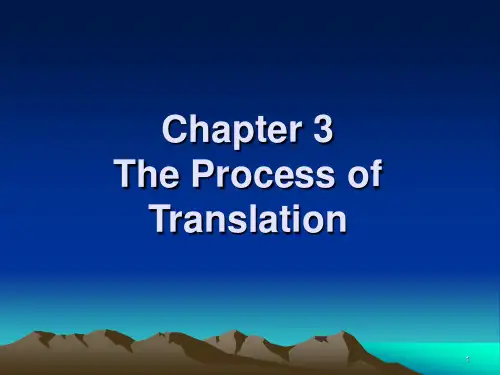
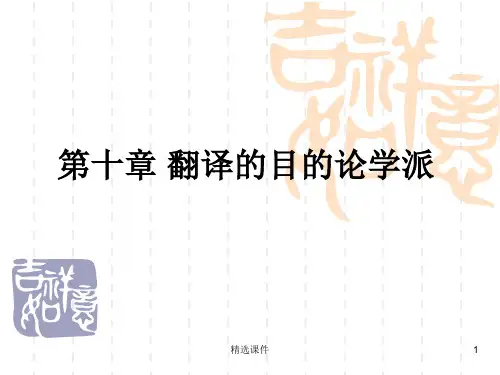
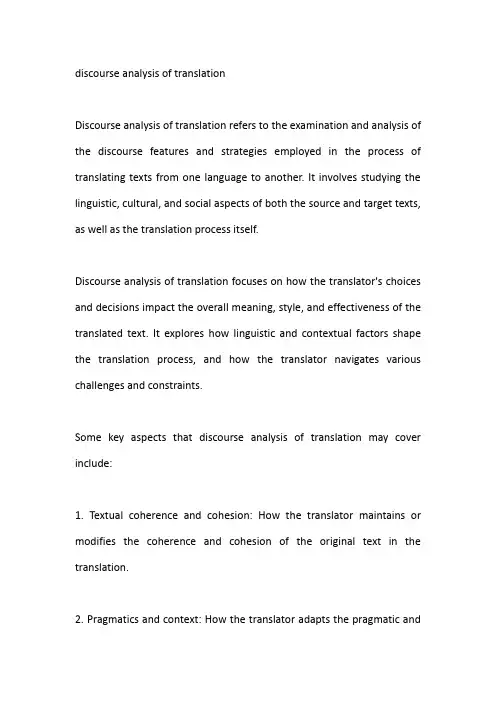
discourse analysis of translationDiscourse analysis of translation refers to the examination and analysis of the discourse features and strategies employed in the process of translating texts from one language to another. It involves studying the linguistic, cultural, and social aspects of both the source and target texts, as well as the translation process itself.Discourse analysis of translation focuses on how the translator's choices and decisions impact the overall meaning, style, and effectiveness of the translated text. It explores how linguistic and contextual factors shape the translation process, and how the translator navigates various challenges and constraints.Some key aspects that discourse analysis of translation may cover include:1. Textual coherence and cohesion: How the translator maintains or modifies the coherence and cohesion of the original text in the translation.2. Pragmatics and context: How the translator adapts the pragmatic andcontextual elements of the source text to the target language and culture.3. Register and style: How the translator deals with differences in register, style, and tone between the source and target texts.4. Ideology and power relations: How the translator negotiates ideological and power dynamics present in the source text and target culture.5. Intertextuality: How the translator handles intertextual references and cultural references in the translation.6. Translation strategies: How the translator employs various translation strategies, such as literal translation, adaptation, compensation, paraphrasing, or cultural substitution.By analyzing these aspects, discourse analysis of translation aims to shed light on the complex nature of translation as a communicative and cultural practice, and to understand the impact of translation choices on the target text and its reception.。

1.笔译何刚强.《笔译理论与技巧》北京:外语教学与研究出版社,2009.孙致礼, 周晔.《高级英汉翻译》北京:外语教学与研究出版社,2009.陈宏薇.《高级汉英翻译》北京:外语教学与研究出版社,2009.李长栓.《非文学翻译》.外语教育与研究出版社.2009姜秋霞,外事笔译[M].北京:外语教学与研究出版社, 2009.何其莘,仲伟合,许钧,《高级文学翻译》外语教育与研究出版社.2009王宏印,《中国文化典籍英译》外语教育与研究出版社.2009王维东,《翻译批评与赏析》外语教育与研究出版社.2009钱多秀等,《计算机辅助翻译》外语教学与研究出版社; 2011.穆雷,《翻译研究方法概论》外语教育与研究出版社.20092.口译柴明颎,《专题口译》,外语与教学研究出版社,2009.7何群,李春怡编著,《外交口译》,外语教学与研究出版社,2011.3梅德明,《高级口译教程》,上海外语教育出版社,2006.赵军峰,《商务英语口译(第二版)》,高等教育出版社,2009.仲伟合,《英语同声传译教程》,高等教育出版社,2008年。
吴冰,《现代汉译英口译教程》,外语教学与研究出版社,2010年。
严诚忠,戚元方编著,《高级口译教程》上海外语教育出版社,2001,3徐亚男,李建英主编,《外事翻译:口译及笔译技巧》世界知识出版社,2003,3秦亚青,《英汉视译》,外语教学与研究出版社,2009仲伟合,《英语口译教程》,高等教育出版社,2007姜秋霞,《实用外事英语翻译》,商务印书馆,2011陶友兰、鲍晓英,《高级英语口译:理论技巧与实践》,上海译文出版社,2008《口译研究方法论》,仲伟合等著,外研社,2012《口译研究的路线图——《口译研究概论的》导读》,仲伟合,王斌华,上外社,2009《口译理论概述》,鲍刚,旅游教育出版社,1998《口译技巧》,刘和平,中国对外翻译出版公司,2001《口译理论与教学》,刘和平,中国对外翻译出版公司,2005冯建中:《实用英语口译教程》,南京:译林出版社,2002年--《口译实例与技巧》,太原:书海出版社,2007林超伦:《实战口译》,北京:外语教学与研究出版社,2004年仲伟合:《英语口译教程》北京:高等教育出版社2006年《英语备考词汇全攻略》(2级,3级),周国强,郭鸿杰,外文出版社《英语口译实务》,梅德明,外文出版社《英语口译全真模拟试题及解析》,卢敏,外文出版社《实用汉字速记》,史江等,成都:四川大学出版社,2000《英语口译笔记法实战指南》,吴钟明,武汉大学出版社,20053.理论许钧,《翻译概论》,译林出版社, 2009.3[英]杰里米•芒迪译者:李德凤等,《翻译学导论——理论与实践》商务印书馆。
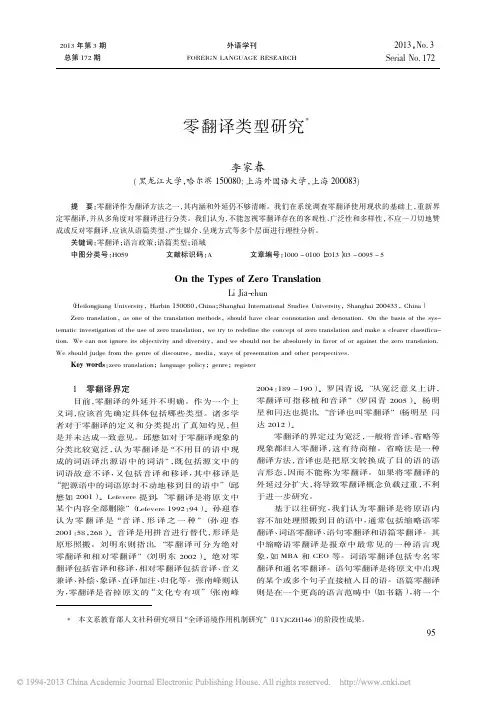
零翻译类型研究*李家春(黑龙江大学,哈尔滨150080;上海外国语大学,上海200083)提要:零翻译作为翻译方法之一,其内涵和外延仍不够清晰。
我们在系统调查零翻译使用现状的基础上,重新界定零翻译,并从多角度对零翻译进行分类。
我们认为,不能忽视零翻译存在的客观性、广泛性和多样性,不应一刀切地赞成或反对零翻译,应该从语篇类型、产生媒介、呈现方式等多个层面进行理性分析。
关键词:零翻译;语言政策;语篇类型;语域中图分类号:H059文献标识码:A文章编号:1000-0100(2013)03-0095-5On the Types of Zero TranslationLi Jia-chun(Heilongjiang University,Harbin150080,China;Shanghai International Studies University,Shanghai200433,China)Zero translation,as one of the translation methods,should have clear connotation and denotation.On the basis of the sys-tematic investigation of the use of zero translation,we try to redefine the concept of zero translation and make a clearer classifica-tion.We can not ignore its objectivity and diversity,and we should not be absolutely in favor of or against the zero translation.We should judge from the genre of discourse,media,ways of presentation and other perspectives.Key words:zero translation;language policy;genre;register1零翻译界定目前,零翻译的外延并不明确。
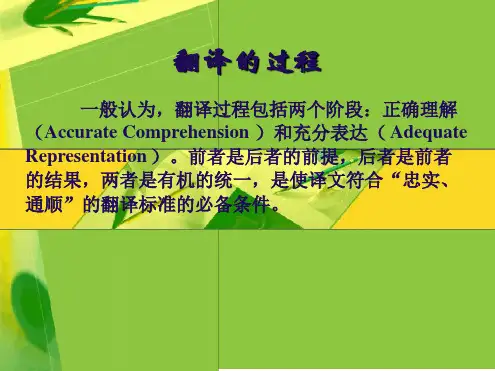
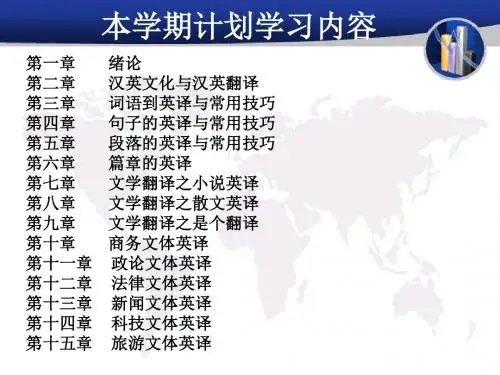
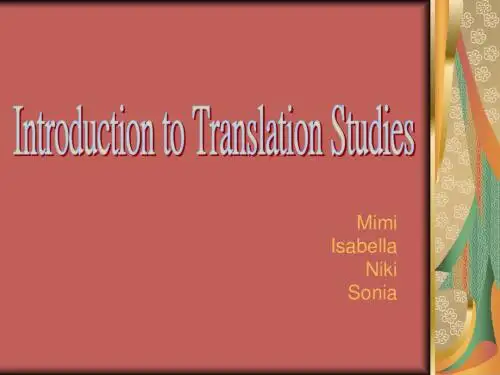
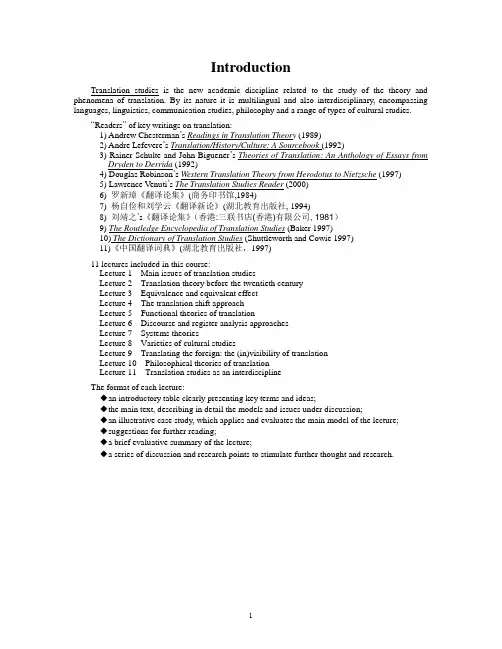
IntroductionTranslation studies is the new academic discipline related to the study of the theory and phenomena of translation. By its nature it is multilingual and also interdisciplinary, encompassing languages, linguistics, communication studies, philosophy and a range of types of cultural studies.“Readers” of key writings on translation:1) Andrew Chesterman’s Readings in Translation Theory (1989)2) Andre Lefevere’s Translation/History/Culture: A Sourcebook (1992)3) Rainer Schulte and John Biguener’s Theories of Translation: An Anthology of Essays fromDryden to Derrida (1992)4) Douglas Robinson’s Western Translation Theory from Herodotus to Nietzsche (1997)5) Lawrence Venuti’s The Translation Studies Reader (2000)6) 罗新璋《翻译论集》(商务印书馆,1984)7) 杨自俭和刘学云《翻译新论》(湖北教育出版社, 1994)8) 刘靖之’s《翻译论集》(香港:三联书店(香港)有限公司, 1981)9) The Routledge Encyclopedia of Translation Studies (Baker 1997)10) The Dictionary of Translation Studies (Shuttleworth and Cowie 1997)11)《中国翻译词典》(湖北教育出版社,1997)11 lectures included in this course:Lecture 1 Main issues of translation studiesLecture 2 Translation theory before the twentieth centuryLecture 3 Equivalence and equivalent effectLecture 4 The translation shift approachLecture 5 Functional theories of translationLecture 6 Discourse and register analysis approachesLecture 7 Systems theoriesLecture 8 Varieties of cultural studiesLecture 9 Translating the foreign: the (in)visibility of translationLecture 10 Philosophical theories of translationLecture 11 Translation studies as an interdisciplineThe format of each lecture:◆an introductory table clearly presenting key terms and ideas;◆the main text, describing in detail the models and issues under discussion;◆an illustrative case study, which applies and evaluates the main model of the lecture;◆suggestions for further reading;◆a brief evaluative summary of the lecture;◆a series of discussion and research points to stimulate further thought and research.Lecture 1 Main issues of translation studiesContents1.1 The concept of translation1.2 What is translation studies?1.3 A brief history of the discipline1.4 The Holmes/Toury ‘map’1.5 Developments since the 1970s1.6 Aim of this course and a guide to lectures1.1 The concept of translationTranslation:the general subject field;the product: the text that has been translatedthe process: the act of producing the translation, or translatingThe process of translation (or translating) involves the translator changing an original written text or the source text (ST) in the original verbal language or the source language(SL) into a written text or the target text (TT) in a different verbal language or the target language (TL).→‘interlingual translation’.Jakobson’s (1959) categories of translation:1. intralingual translation, or ‘rewording’: ‘an interpretation of verbal signs by means of othersigns of the same language’;2. interlingual translation, or ‘translation proper’: ‘an interpretation of verbal signs by means ofsome other language’;3. intersemiotic translation, or ‘transmutation’: ‘an interpretation of verbal signs by means of signsof non-verbal sign systems’).1.2 What is translation studies?James S. Holmes (“The Name and Nature of Translation Studies”, 1972): Translation Studies is concerned with ‘the complex of problems clustered round the phenomenon of translating and translations’ (Holmes 1988/2000: 173).Mary Snell-Hornby (Translation Studies: An Integrated Approach, 1988): ‘the demand that translation studies should be viewed as an independent discipline . . . has come from several quarters in recent years’.Snell-Hornby (1995): ‘the breathtaking development of translation studies as an independent discipline’and the ‘prolific international discussion’ on the subject.Mona Baker (The Routledge Encyclopedia of Translation, 1997): ‘exciting new discipline, perhaps the discipline of the 1990s’Two ways translation studies has become more prominent:1) A proliferation of specialized translating and interpreting courses at both undergraduate and postgraduate level.In the UK in the 1960s: the first specialized university postgraduate courses in interpreting and translating established.In the UK in the academic year 1999/2000: at least 20 postgraduate translation courses and several designated ‘Centres of Translation’.250 university-level bodies in over 60 countries offering four-year undergraduate degrees and/or postgraduate courses in translation, training professional commercial translators and interpreters. (Caminade & Pym, 1995)2) Courses focusing on the practice of literary translation:In the UK: (1) Middlesex University; (2) the University of East Anglia (Norwich) (which houses the British Centre for Literary Translation).In Europe: a network of centres where literary translation is studied, practised and promoted, including Norwich, Amsterdam (the Netherlands), Arles (France), Bratislava (Slovakia), Dublin (Ireland), Rhodes (Greece), Sineffe (Belgium), Strälen (Germany), Tarazona (Spain) and Visby (Sweden).The 1990s also saw a proliferation of conferences, books and journals on translation in many languages.Long-standing international translation studies journals:Babel (the Netherlands)Meta (Canada)Across Languages and Cultures (Hungary)Literature in Translation (UK)Perspectives: Studies in Translatology (Denmark)Target (Israel/Belgium)The Translator (UK)Parallèles (Switzerland) and Traduire (France)Cadernos de Tradução (Brazil)Rivista Internazionale di Tecnica della Traduzione (Italy)Turjuman (Morocco)The main European publishers publishing books in translation studies:John BenjaminsMultilingual MattersRodopiRoutledgeSt JeromeProfessional publications dedicated to the practice of translation in the UKThe Linguist of the Institute of LinguistsThe ITI Bulletin of the Institute for Translating and InterpretingIn Other Words, the literary-oriented publication of the Translators’ AssociationTRANSST (Israel)BET (Spain)Key themes of international translation conferences (1999–2000):• translation and training translators (Bratislava, Slovakia);• literary translation (Mons, Belgium);• research models in translation studies (UMIST, Manchester, UK);• gender and translation (Norwich, UK);• translation as/at the crossroads of culture (Lisbon, Portugal);• translation and globalization (Tangiers, Morocco);• legal translation (Geneva, Switzerland);• translation and meaning (Maastricht, the Netherlands and Lodz, Poland);• the history of translation (Leon, Spain);• transadaptation and pedagogical challenges (Turku, Finland);• translation-focused comparative literature (Pretoria, South Africa and Salvador, Brazil).From being a little-established field a relatively short time ago, translation studies has now become one of the most active and dynamic new areas of research encompassing an exciting mix of approaches.1.3 A brief history of the disciplineWritings on the subject of translating go far back in recorded history.Cicero and Horace (first century BCE) and St Jerome (fourth century CE)The Greek Septuagint BibleStudy of translation developed into an academic discipline only in the second half of the 20th century.The grammar-translation method fell into increasing disrepute with the rise of the direct method or communicative approach to English language teaching in the 1960s and 1970s.▲Translation workshopIn the US, translation was promoted in universities in the 1960s by the translation workshop concept. The translation workshops were first established in the universities of Iowa and Princeton with the intention of introducing new translations into the target culture and for the discussion of the finer principles of the translation process and of understanding a text.▲Comparative literatureIn comparative literature, literature is studied and compared transnationally and transculturally, necessitating the reading of some literature in translation. This would later link into the growth of courses of the cultural studies type.▲Contrastive analysisContrastive analysis is the study of two languages in contrast in an attempt to identify general and specific differences between them. It developed into a systematic area of research in the USA from the 1930s onwards and came to the fore in the 1960s and 1970s. The contrastive approach heavily influenced other studies, such as Vinay and Darbe lnet’s (1958) and Catford’s (1965), which overtly stated their aim of assisting translation research. However, contrastive analysis does not incorporate sociocultural and pragmatic factors, nor the role of translation as a communicative act.Nevertheless, the continued application of a linguistic approach in general, and specific linguistic models such as generative grammar or functional grammar, has demonstrated an inherent and gut link with translation.The evolving field of translation studies can point to its own systematic models that have incorporated other linguistic models and developed them for its own purposes.The construction of the new discipline does not consider translation as primarily connected to language teaching and learning, but as the specific study of what happens in and around translating and translation.The more systematic approach to the study of translation began in the 1950s and 1960s:• Jean-Paul Vinay and Jean Darbelnet’s contrastive approach(1958): categorizing what they saw happening in the practice of translation between French and English;• Alfred Malblanc (1963) did the same for translation between French and German;• Georges Mounin(1963): examining linguistic issues of translation;• Eugene Nida (1964): incorporating elements of Chomsky’s generative grammar as a theoretical underpinning of his books.The word ‘science’ was used by Nida in Toward a Science of Translating (1964).The German equivalent, ‘Übersetzungswissenschaft’, was taken up by Wolfram Wilss, Koller and the Leipzig school (where Kade and Neubert became active).1.4 The Holmes/Toury ‘map’A seminal paper in the development of the field as a distinct discipline was James S. Holmes’s (1972) ‘The name and nature of translation studies’. Gentzler describes it as ‘generally accepted as the founding statement for the field’ (1993: 92).Figure 1.1Two objectives of the ‘pure’ areas of research:1. The description of the phenomena of translation (descriptive translation theory);2. The establishment of general principles to explain and predict such phenomena (translationtheory). (Holmes 1988b/2000: 176–81)The ‘theoretical’ branch is divided into general and partial theories:‘General’ theoretical studies: describing or accounting for every type of translation and makinggeneralizations that will be relevant for translation as a whole.‘Partial’ theoretical studies: (to be discussed below).Three possible foci of descriptive translation studies (DTS): examination of (1) the product, (2) the function and (3) the process:1. Product-oriented DTS examines existing translations, including the description or analysis ofa single ST–TT pair or a comparative analysis of several TTs of the same ST (into one or moreTLs). These smaller-scale studies can build up into a larger body of translation analysis looking at a specific period, language or text/discourse type. Larger-scale studies can be either diachronic (following development over time) or synchronic (at a single point or period in time). ‘One of the eventual goals of product-oriented DTS might possibly be a general history of translations – however ambitious such a goal might sound at this time’. (Holmes, 1988/2000: 177)2. Function-oriented DTS refers to the description of the ‘function[of translations] in therecipient sociocultural situation: it is a study of contexts r ather than texts’ (Holmes, 1988/2000: 177). Issues that may be researched include which books were translated when and where, and what influences they exerted. This area (then termed ‘socio-translation studies’, but now called cultural-studies-oriented translation) was less researched at that time, but is more popular in current work on translation studies.3. Process-oriented DTS is concerned with the psychology of translation, trying to find out whathappens in the mind of a translator, but has still not yet been systematically analyzed.The results of DTS research can be fed into the theoretical branch to evolve either a general theory of translation or partial theories of translation ‘restricted’ according to the following subdivisions:• Medium-restricted theories: subdividing according to translation by machine and humans, with further subdivisions according to whether the machine/computer is working alone or as an aid to the human translator, to whether the human translation is written or spoken and to whether spoken translation (interpreting) is consecutive or simultaneous.• Area-restricted theories:restricted to specific languages or groups of languages and/or cultures. It is closely related to work in contrastive linguistics and stylistics.• Rank-restricted theories: restricted to a specific level of the word or sentence or text.• Text-type restricted theories:related to specific discourse types or genres, such as literary, business and technical translation. Text-type approaches came to prominence with the work of Reiss and Vermeer in the 1970s.• Time-restricted: referring to theories and translations limited according to specific time frames and periods (i.e. the history of translation).• Problem-restricted theories: referring to specific problems (such as equivalence) or whether universals of translated language exist.Several different restrictions can apply at any one time. For example, the study of the translation of novels would be area restricted, text-type restricted and time restricted.The ‘applied’ branch of Holmes’s framework concerns:• translator training: teaching methods, testing techniques, curriculum design;• translation aids: such as dictionaries, grammars and information technology;•translation criticism: the evaluation of translations, including the marking of student translations and the reviews of published translations.Translation policy: the translation scholar advise on the place of translation in society, including what place, if any, it should occupy in the language teaching and learning curriculum.Figure 1.2The merit of Holmes’s divisions: they allow a clarification and a division of labour between the various areas of translation studies which, in the past, have often been confused (Toury, 1995: 9) The crucial role of Holmes’s paper: delineating the potential of translation studies.‘Translation policy’ would nowadays far more likely be related to the ideology that determines translation than was the case in Holmes’s description.The restrictions of Holmes’s divisions:1) A discourse-type and a text-type restriction2) Inclusion of interpreting as a sub-category of human translation3) Omission of any mention of the individuality of the style, decision-making processes andworking practices of human translators involved in the translation process (Pym, 1998: 4) 1.5 Developments since the 1970sThe surge in translation studies since the 1970s has seen different areas of Holmes’s map come to the fore.◆Contrastive analysis has fallen by the wayside.◆The linguistic-oriented ‘science’ of translation has continued strongly in Germany, but theconcept of equivalence associated with it has declined.◆Germany has seen the rise of theories centred around text types (Reiss) and text purpose (theskopos theory of Reiss and Vermeer).◆The Hallidayan influence of discourse analysis and systemic functional grammar has beenprominent over the past decades, especially in Australia and the UK, and has been applied to translation in works by Bell (1991), Baker (1992) and Hatim and Mason (1990, 1997).◆The descriptive approach (originating in comparative literature and Russian Formalism) rose inthe late 1970s and the 1980s.◆In Tel Aviv, Itamar Even-Zohar and Gideon Toury have pursued the idea of the literarypolysystem in which different literatures and genres, including translated and non-translated works, compete for dominance.◆The polysystemists have worked with a Belgium-based group (including José Lambert and thelate André Lefevere), and with the UK-based scholars Susan Bassnett and Theo Hermans.◆The Manipulation of Literature: Studies in Literary Translation (Hermans, 1985) gave rise tothe name of the ‘Manipulation School’ and held sway for much of the following decade.◆The 1990s saw the incorporation of new schools and concepts:●Canadian-based translation and gender research led by Sherry Simon;●The Brazilian cannibalist school promoted by Else Vieira;●Postcolonial translation theory, with the prominent figures of the Bengali scholarsTejaswini Niranjana and Gayatri Spivak;●In the USA, the cultural-studies-oriented analysis of Lawrence Venuti, who champions thecause of the translator.1.6 Aim of this course and a guide to LecturesLecture 2 describes some of the major issues discussed in writings about translation up to the middle of the 20th century. This huge range of over two thousand years, beginning with Cicero in the first century BC, focuses on the ‘literal vs. free’ translation debate. It aims to initiate discussion on some of the key issues.Lecture 3deals with the concepts of meaning, equivalence and ‘equivalent effect’, encompassing Nida’s generative-influenced model of translation transfer and his concepts of formal equivalence and dynamic equivalence. Newmark’s categories of semantic translation and communicative translation are also discussed, as is Koller’s analysis of equivalence.Lecture 4 details attempts that have been made to provide a taxonomy of the linguistic changes or ‘shifts’ which occur in translation. The main model described here is Vinay and Darbelnet’s classic taxonomy, but reference is also made to Catford’s linguistic model and van Leuven-Zwart’s translation shift approach from the 1980s.Lecture 5 covers Reiss and Vermeer’s text-type and skopos theory of the 1970s and 1980s and Nord’s text-linguistic approach. Translation is analyzed according to text type and function in the TL culture, and concepts of text analysis –such as word order, information structure and thematic progression – are employed.Lecture 6 considers House’s register analysis model and the development of discourse-oriented approaches in the 1990s by Baker and Hatim and Mason, who make use of Hallidayan linguistics to examine translation as communication within a sociocultural context.Lecture 7 investigates systems theories and the field of target-oriented ‘descriptive’ translation studies, following Even-Zohar, Toury and the work of the Manipulation School.Lecture 8 examines varieties of cultural studies approaches in translation studies. These start with Lefevere’s work of the 1980s and early 1990s and move on to more recent developments in gender studies and translation (in Canada) and to postcolonial translation theories (in India, Brazil and Ireland).Lecture 9 follows Berman and Venuti in examining the foreign element in translation and the ‘invisibility’ of the translator. The idea is explored that the practice of translation, especially in the English-speaking world, is considered to be a derivative and second-rate activity, and that the prevailing method of translation is ‘naturalizing’. The role of literary translators and publishers is also described.Lecture 10 investigates a selection of philosophical issues of language and translation, ranging from Steiner’s ‘hermeneutic motion’, Pound’s use of archaisms, Walter Benjamin’s ‘pure’ language, and Derrida and the deconstruction movement.Lecture 11sets out an interdisciplinary approach to translation studies. It discusses Snell-Hornby’s‘integrated approach’and looks at recent studies that have combined linguistic andcultural analysis. The future of translation studies and the role of modern technologies, including the internet, are also discussed.SummaryTranslation studies is a relatively new academic research area that has expanded explosively in recent years. While translation was formerly studied as a language-learning methodology or as part of comparative literature, translation ‘workshops’ and contrastive linguistics courses, th e new discipline owes much to the work of James S. Holmes, whose ‘The name and nature of translation studies’ proposed both a name and a structure for the field. The interrelated branches of theoretical, descriptive and applied translation studies have structured much recent research and have assisted in bridging the gulf that had grown between the theory and practice of translation.Discussion and research points1. How is the practice of translation (and interpreting) structured in China? How many universities offer first degrees in the subject? How many postgraduate courses are there? How do they differ? Isa postgraduate qualification a prerequisite for working as a professional translator?2. Find out how research-based translation studies fits into the university system in China. How many universities offer ‘translation studies’ (or similar) courses? In what ways do they differ from or resemble each other? In which university departments are they housed? What do you conclude is the status of translation studies in China?3. What specific research in translation studies is being carried out in China? How do you find out? Is the work being carried out by isolated researchers or by larger and coordinated groups? How, if at all, would it fit in with Holmes’s‘map’ of translation studies?4. Trace the history of translation and translation studies in China. Has the focus been mainly on the theory or on the practice of translation? Why do you think this is so?Key textsHolmes, J. S. (1988b/2000) ‘The name and nature of translation studies’, in L. Venuti (ed.) (2000), pp. 172–85.Jakobson, R. (1959/2000) ‘On linguistic aspects of translation’, in L. Venuti (ed.) (2000),pp. 113–18.Leuven-Zwart, K. van and T. Naaijkens (eds) (1991) Translation Studies: State of the Art, Amsterdam: Rodopi.Toury, G. (1991) ‘What are descriptive studies in translation likely to yield apart from isolated descriptions?’, in K. van Leuven-Zwart and T. Naaijkens (eds) (1991), pp. 179–92.。
2023年英语一阅读理解逐句译文第一段:1. 阅读全文 - Read the passage2. 译文 - Translation第二段:1. 文章主题 - Topic of the passage2. 译文 - Translation第三段:1. 文章内容 - Content of the passage2. 译文 - Translation第四段:1. 文章段落解析 - Analysis of the passage2. 译文 - Translation第五段:1. 结论 - Conclusion2. 译文 - Translation第六段:1. 参考资料 - References2. 相关信息 - Related links在2023年的英语一考试中,阅读理解部分一直是备受考生关注的题型之一。
本文将针对2023年英语一阅读理解部分的一篇文章进行逐句译文,帮助考生更好地理解文章内容。
第一段:1. 阅读全文 - Read the passage2. 译文 - TranslationIn the following passage, some of the words, phrases, and expressions are underlined. Please translate the underlined parts into Chinese.在以下文章中,一些单词、短语和表达被划线了。
请将划线部分翻译成中文。
第二段:1. 文章主题 - Topic of the passage2. 译文 - TranslationThe passage is about the benefits of reading for children and how it can positively impact their development.本文主要关于阅读对儿童的好处以及它对他们发展的积极影响。
第三段:1. 文章内容 - Content of the passage2. 译文 - TranslationThe passage discusses how reading can improve children's language skills, cognitive abilities, and empathy. It also emphasizes the importance of cultivating a love for reading from a young age.本文讨论了阅读如何提高儿童的语言能力、认知能力和同理心。
2020考研英语:词汇analysis的中文翻译解析 考研英语有许多题目组成,方便大家及时了解,下面由出国留学网小编为你精心准备了“2020考研英语:词汇analysis的中文翻译解析”,持续关注本站将可以持续获取更多的考试资讯! 2020考研英语词汇:analysis的中文翻译解析 analyse的中文翻译及音标 动词 1.分析(将事物分解成各部分以研究其性质或结构) 2.观察并解释(某事物)研究 3.心理分析 英语解释 subject to psychoanalytic treatment make a mathematical, chemical, or grammatical analysis of break down into components or essential features break down into components or essential features consider in detail and subject to an analysis in order to discover essential features or meaning 相似短语 analyse ... into ... 把…分解成… factor analyse phr. 因子分析 analyse away 把…分解掉 neutronic analyse 中子分析 相似单词 analyse v. 1.分析(将事物分解成各部分以研究其性质或结构) 2.观察并解释(某事物)研究 3.心理分析 新单词 neritidae怎么翻译及发音 n. 蜑螺科 snicked是什么意思及用法 [ snick ]的过去式 plutocratically的中文意思 [ plutocracy ]的相关副词[ plutocrat ]的相关副词[ plutocratic ]的相关副词[ plutocratical ]的相关副词 4142的中文释义 four thousand one hundred and forty two 7142什么意思及同义词 seven thousand one hundred and forty two mallards是什么意思及反义词 [ mallard ]的复数形式 2001的中文解释 two thousand and one rewires是什么意思及用法 [ rewire ]的第三人称单数[ rewiring ]的第三人称单数 2020考研词汇:analogy的翻译应用 analogy是什么意思及用法 名词 1.类似,相似 2.类推,类推法 词形变化 复数 analogies 英语解释 the religious belief that between creature and creator no similarity can be found so great but that the dissimilarity is always greater language can point in the right direction but any analogy between God and humans will always be inadequate drawing a comparison in order to show a similarity in some respect an inference that if things agree in some respects they probably agree in others 例句 This "lattice analogy" seeks to capitalize on well-established methods for analysis of framed structures 搞这种“格架模型”是为了可以利用成熟的分析钢架结构方法。
US-China Foreign Language, April 2019, Vol. 17, No. 4, 177-182 doi:10.17265/1539-8080/2019.04.005A Brief Analysis of Subtitle Translation Based on theIntercultural Perspective—A Case Study of Kung Fu PandaLIU Xin, XIONG ShuhuiUniversity of Shanghai for Science and Technology, Shanghai, ChinaFilms and television programs are playing an irreplaceable role in serving as the carrier of culture. With the risingof China’s national strength, language and culture have changed in some ways in the process of external exchange,which in turn gives an impetus to the international popularity of Chinese culture. In the case of movie Kung FuPanda, the thesis mainly focuses on the movie subtitling with related to the Chinese characteristics as well as theEnglish translations that deal with the Chinese culture. Through the comparative analysis of the three versions, thispaper compares the subtitle translation between Chinese and English from a cross-cultural perspective, so as tofurther demonstrate the influence of Chinese culture on English films.Keywords: intercultural communication, Kung Fu Panda, subtitle translationIntroductionIn the recent years, the popularity of Chinese culture and the release of so many foreign films with plenty of Chinese elements have rendered Chinese culture more and more important. In this thesis, I will try to analyzeand compare three different translated versions of subtitles of the movie Kung Fu Panda with the purpose ofdiscussing different methods of translating China English and demonstrating the influence of Chinese cultureon the film subtitle.Chinese Elements in Hollywood MoviesChinese characters began to appear in American films in the end of 19th century. We can only see the poverty, ignorance, and numbness of these characters. Since the Cold War, American directors prefer to laughat China through the details of the film. However, Chinese elements are becoming more and more active andattractive. Nowadays, many of Hollywood’s biggest films are incorporating a greater number of Chineseelements into them. The following is a list of these elements.The Chinese CharactersMore and more Chinese actors and actresses achieved international stardom and exerted greater influence on the international stage. In addition to the common supporting roles, Chinese actors and actresses have moreopportunities to be the leading roles than before.LIU Xin, Master, College of Foreign Languages, University of Shanghai for Science and Technology, Shanghai, China.XIONG Shuhui, Ph.D., English Department of College of Foreign Languages, University of Shanghai for Science andTechnology, Shanghai, China.All Rights Reserved.A BRIEF ANALYSIS OF SUBTITLE TRANSLATION178 Symbols of ChinaKung fu and panda seem to be two typical elements related to China; this also shows that in the film. In Ice Age 2, the squirrel sounds much like Li Xiaolong’s screams in his film. The iconic pose of Keanu Reeves is bent backwards in The Matrix , a classic of kung fu master Huang Feihong in real life.The Subtitle Translation of Kung Fu PandaKung Fu Panda is a masterpiece of Hollywood which mixes lots of Chinese cultural elements to Chinese cultural images. In the following parts, the examples of translation from three versions: DVD, FRTVS (风软字幕组), TEL (TEL 字幕组), will be analyzed in detail.The Brief Review of the MovieThe story of Kung Fu Panda is set in the Valley of Peace, a martial arts master-studded place of ancient China. Panda Po has always dreamed of becoming a “Kung Fu Emperor” since childhood. One day, word comes that the aged Mater Shifu would select Dragon Warrior at the Jade Palace. Po is accidentally involved in this martial arts competition held among the Furious Five and unexpectedly selected as the Dragon Warrior responsible for defeating escaped prisoner snow leopard Tarou and saving the Valley of Peace.Culture-Loaded WordsAs Kung Fu Panda sets in ancient China, there are lots of expressions heavily loaded with the Chinese culture. These elements should be rendered in a way that makes the Chinese audience feel at ease. This film reflects the Chinese social and cultural life, so its dialogue often contains the words with Chinese characteristics.Culture-loaded words are words with unique national cultural connotations as well as social cultural significance based on original meaning or conceptual meaning. Culture-loaded words require translators to precisely convey semantic information in original language, and simultaneously maintain original cultural features to the uttermost. During translation process, translators have to consider multiple factors such as original language features, translation objective, and target reader features and find best translation techniques as far as possible. Targeted at relatively great discrepancy in English cultural translation, there are four translation strategies in culture-loaded word translation.(1) Foreignization: maintaining connotations of original language culture by literal translation method or transliteration method.(2) Domestication: realizing functional equivalence by free translation method or replacing inaccessible or ambiguous culture words.(3) Integration: illustrating original language and maintaining cultural connotations of original language for the convenience of audiences.(4) Deletion: reducing inference of subtitle on acoustic image by directly deleting culture words hard to translate and unassociated with textual coherence.Proper names. The names of characters in the films should be as rendered in a Chinese way to make the Chinese audiences feel cordial as possible, written in a way as if they were originally written in Chinese.The following table lists three versions of subtitle translation:All Rights Reserved.A BRIEF ANALYSIS OF SUBTITLE TRANSLATION 179Table 1Four Versions of the Name TranslationNames of roles Literal translation DVD FRTVS TELPo 波阿宝阿波阿宝Monkey 猴子金猴猴子金猴Crane 鹤仙鹤仙鹤仙鹤Viper 毒蛇灵蛇毒蛇灵蛇Tigress 母老虎娇虎老虎娇虎Mantis 螳螂螳螂螳螂螳螂Tai Lung 太郎大龙/黑豹太郎泰狼大龙Zeng 曾小善飞鸽小善The Furious Five 暴怒的五人盖世五侠无畏五侠威猛五侠The Dragon Warrior 龙战士神龙大侠神龙武士神龙大侠Whispering Warriors 低语武士昵喃武士低语武士之瓮昵喃武士Tenshu Army 藤树军队天守大军天书军天守大军Master Flying Rhino 飞行犀牛师傅飞犀牛大侠飞行犀牛大师飞天犀牛大师Jade Palace 玉石殿翡翠宫翡翠宫翡翠宫Example 1Po and ZengFrom Table 1, it can be seen that literal translation may be rigid, making the roles lose their lively character and attraction.In DVD version, the main character Po’s name is translated to “宝” instead of transliteration of “波”. The origin of “Po” can be explained by the film creators through the transliteration of Chinese word “宝” as “Po”,because the word “宝” itself in Chinese is a popular word which was given the meaning of “hold something orsomebody in high esteem”. The addition of “阿” conforms to the way Chinese people name their children,usually with two characters.Example 2Master Oogway & ShifuThe tortoise is generally regarded as a symbol of longevity and representative of wisdom in Chinese traditional culture. Because of its longevity, it can experience the life progress that many other creatures cannotundergo. In Kung Fu Panda, a venerable master is a tortoise; he is Po’s Shifu and called “Master Oogway”which is translated into “乌龟大师”. He is also the represent of reigns supreme and the incarnate of wisdom.Using the Pinyin transliteration words “乌龟大师” directly, obvious, this word is very strange to foreignaudience, but just due to this strange pronunciation and spelling form that can arouse the curiosity of audienceand experience the mysterious state of master. Why not called this role “Master Tortoise”? Because tortoise is aslow, ugly, and common animal in western cultural image, the use of the strange Chinese transliteration wordcan add to make that image more mysterious and exotic.Another Chinese transliteration words is “Master Shifu”. “Master Shifu” reflects the cultural images which indicate “teacher’s dignity” totally by the pronunciation. The word “Shifu” directly used in the film shows theprofound influence of Chinese culture to the world culture. It can even be predicted that in the future, Shifu willbecome a member of the English vocabulary.Example 3The Furious FiveAll Rights Reserved.A BRIEF ANALYSIS OF SUBTITLE TRANSLATION180 “Furious” always is marked by extreme and violent energy, which gives people a power of justice. If literal translated the word into Chinese: “暴怒的”, it may lose its grandeur. But if translated it into “威猛”, “无畏”, and “盖世”, then a brave and justice image stands vividly on the paper.“侠” is a character very familiar to the Chinese audience and it is often used to refer to heroes. The two translations demonstrate the superior kung fu skills and their strong sense of justice.Example 4The Dragon Warrior“Dragon” has always been a controversial image in the eyes of scholars, because “Dragon” in the western cultural image is nothing but an evil creature which has huge wings and powerful force. In Kung Fu Panda , Panda Po was selected by Master Oogway as the “Dragon Warrior” which was a very noble and righteous title in everyone’s eyes. The use of “Dragon” in the film has been completely sinicized, due to that fact that it absorbed and advocated Chinese elements actively. So the word “Dragon” can be regarded as the Chinese English.Example 5The Jade Palace“Jade” means “玉” in Chinese. But translating “The Jade Palace” into “玉宫” may be a little stiff. Since the film is set in ancient China, the rendering to “翡翠” fits in the style of the grand palace and makes audiences to be charmed by the quaintness of the picture.Terms related to kung fu. China is famous for its profound culture of kung fu all over the world. There are many fight scenes and kung fu terms in this film. A large number of kung fu words are used and they should be translated back to Chinese by using special kung fu terms that are often used in Chinese Wuxia filmsand series.Table 2Other Kung Fu-Related ExpressionsNames of kung fuDVD FRTVS TEL The Dragon Scroll神龙秘笈 神龙手卷 神龙秘籍 Feet of Fury佛山无影脚 佛山无影脚 愤怒之脚 The Invisible Trident of Destiny隐形天命三叉戟 隐形命运网 隐形天命三叉戟 The Wuxi Finger Hold无极拈花指 弹指神功 无须铁指扣 Wings of Justice 正义之翼正义之翼 正义之翼Example 6The Dragon ScrollThese two versions all show the tradition that Chinese people are very worshiping the dragon and kung fu myths. The addition of “神” and “秘” make the translation not only a four-character expression in conformity with the way of expression in Chinese but also is closer to Wuxia.Example 7Feet of FuryIf literal translated “Feet of Fury” to “愤怒之脚”, it would be displayed too straightforwardly. The translator uses the commonly-used term of kung fu in Chinese, “佛山无影脚”, which is straight to the point and easy for the Chinese audience to gasps the point.All Rights Reserved.A BRIEF ANALYSIS OF SUBTITLE TRANSLATION 181Example 8The Wuxi Finger HoldAlthough these three versions all reflect the skill of Wuxia, but “无极拈花指” not only can show the power of fingers completely, but also is romantic and rich in poetry.Linguistic ElementsApart from numerous adoptions of typical Chinese English represented by transliterated words, there are also considerable expressions carried with Taoist culture in the film. Though the cultural images of Taoismwhich has influenced China for thousands of years seem vague here, they are well organized into a systematicalstructure. In this film, Oogway is delineated as the incarnation of the sage with paramount power. Though tacitand silent, he always says classical sentences worthy of pondering. In another word, his words are filled withthe connotations and doctrines of Chinese Taoism such as “passive inaction” and “following the divine Tao”.As a result, these words and expressions can be studied as Chinese English.Example 9“One often meets his destiny on the road he takes to avoid it.”A: 予欲避之,反促遇之。
姜倩,何刚强.翻译概论(翻译专业本科生系列教材)翻译概论(翻译专业本科生系列教材)姜倩//何刚强出版社:上海外语教育出版社页数:260出版日期:2008-09-01◆目录上篇翻译是什么第一章从翻译的比喻认识翻译的本质一、从对翻译或翻译者的宏观比喻来看翻译的本质二、从对翻译操作过程的比喻来看翻译的本质本章小结理解设问讨论题译论咀英Further Reading第二章翻译的原则一、概念的界定二、中外翻译原则的代表性观点三、翻译原则之厘定本章小结理解设问讨论题译论咀英Further Reading第三章翻译与文化一、语言与文化二、文化差异与翻译本章小结理解设问讨论题译论咀英Further Reading第四章译者必备的素质一、译者的责任二、译者的素质三口译员的特殊素质本章小结理解设问讨论题译论咀英Further Reading第五章翻译的创意一、翻译的创造性二、创意与忠实本章小结理解设问讨论题译论咀英Further Reading第六章翻译的目的一、翻译的交际功能二、翻译的文化功能本章小结理解设问讨论题译论咀英Further Reading第七章翻译的分类一、狭义翻译与广义翻译二、文学翻译与非文学翻译三、笔译与口译四、翻译的变体种种本章小结理解设问讨论题译论咀英Further Readingg第八章机器翻译一、什么是机器翻译二、机器翻译原理三、历史与展望本章小结理解设问讨论题译论咀英Further Reading下篇翻译做什么第九章理解与翻译一、翻译的基本过程二、理解是翻译的前提三、理解与表达本章小结理解设问讨论题译论咀英Further Reading第十章直译与意译一、直译与逐字译的区别二、意译的定义种种三、直译与意译的各自功能四、直译与意译的结合本章小结理解设问讨论题译论咀英Further Reading第十一章翻译的等值与近似一、翻译的等值二、等值的层次三、翻译近似四、可译性与不可译性本章小结理解设问讨论题译论咀英Further Reading第十二章翻译的归化与异化一、归化与异化的概念及其历史沿革二、如何正确认识翻译中的归化与异化问题三、技术层面上的归化与异化处理本章小结理解设问讨论题译论咀英Further Reading第十三章形合与意合一、形合与意合的概念二、形合与意合在英汉语中的表现三、形合意合与英汉互译本章小结理解设问讨论题译论咀英Further Reading第十四章翻译与风格一、什么是风格二、风格的可译与不可译三、风格的表现手段四、风格的转移本章小结理解设问讨论题译论咀英Further Reading第十五章翻译的"得"与"失"一、翻译:"失"在何处二、翻译:有"失"必有"得"本章小结理解设问讨论题译论咀英Further Readingg主要参考书目英汉术语对照表。
Translation1. Mr. Manager, may I take a day off tomorrow? My mother is coming to see me.表示将来的will, be going to 与现在进行时三者用法的异同1.说话时临时起意或表示“愿意,决心要”的将来行动→willA: This is so heavy a box. B: I will help you to carry it.2.在此之前主语单方面的决定或计划(并非临时起意)→be going toA: why did you buy this paint? B: I’m going to paint my bedroom tomorrow.注:come, go, arrive, leave, fly, start, travel, drive等表示从甲地到乙地的行动的动词,stay, remain等表示位置的动词,do以及表示吃喝的have(后接食物或饮料)可以(并非必须)用现在进行时代替be going to 表示主语单方面的决定的将来行动。
3.说话时,主语已和他人约定的将来行动→现在进行时My wife has an appointment with a doctor. She is seeing Dr. Wang next Monday.4.非既定计划,预测将来的行动或可能发生的事;或不明确是否预先计划→ will/ be going toI will/am going to climb that mountain one day.5.根据某种征兆预测“最近”会如何→be going to; 根据个人看法预测“迟早”会如何→ willListen, there is a strange sound. The lift is going to be break down; we had better get out on the next floor.The lift will break down since it is often overloaded.c.f. My mother will come to see me. (be doing更好: the present continuous tense indicating a scheduled action in the near future. p.3I’m flying back to America tomorrow.)Exercise:A: Where’s your car?B: It is in the garage for repair.A: How are you going to get to work?B: I am going to take the bus. (送车去修时已决定坐公交,既定决定,不可用will;单方决定并非约定,不可用I’m taking)A: You needn’t take the bus. I will drive you. (A临时决定载B,并非预定计划或约定)LaterC: How are you going to get to work, Mr. B?B: Mr. A is driving me. (A和B已经约定)2. The police offered a reward for clues about the bank robbers.sin / crime (Every crime is normally a sin, but not every sin is necessarily a crime. )sin: an action, thought or way of behaving that is wrong according to religious laws. // an action or way of behaving that you think is morally wrong →sinner: someone who does sth morally wrong or does not obey religious laws.Greed and lying are sins. // it is a sin to waste food when so many people are starving.crime: an illegal activity or action. → criminal: one who has committed a crime.A convicted criminal: one who has been judged guilty in a court of law. 已决犯,既决犯A hardened criminal: one who has committed many crimes. = A habitual criminalA wanted criminal: 通缉犯Generic words vs. specific words:murder: the crime of killing someone deliberately→ murderer: someone who commits murderrobber: someone takes money or property illeglly, often by using threats and violence.reward / awardreward: 1)sth. good that happens or that you receive because of something you have done. 因做某事给予的报酬a reward for doing sth. / give sb. a reward for sth. (for =because of) = reward sb. for sth因某事奖赏~+for You deserve a day off as a reward for working so hard.(c.f. reward sb. with sth: they rewarded the winner with flowers.以某物奖赏)2) money that someone receives for finding and returning sth. or for helping the police悬赏:post a reward / offer a rewardaward: 1)a prize or other reward that is given to someone who has achieved something. 奖品,奖状→ money granted to a student at a university 奖学金win/receive an award // give/ grant present an award2) an amount of money or judgment given by a court of law 法庭判定的金额(赔偿金等)3. When I was ill last week, she offered to look after my child.Offer to help me look after 可以不用helpoffer sb. sth: They haven’t offered me the job yet.offer sth. to sb.: The police are offering a reward to anyone with information about the crime/the bank robber.offer sb. sth for sth.: I offered Jim $5000 for his car.offer to do sth.: I do think you should have offered to help.4. Except for the small kitchen, the flat is satisfactory.Except for the kitchen is small, the flat is satisfying. Except for 不能接从句→ Except that the kitchen is small,…satisfying, satisfactory, satisfiedsatisfied:由过去分词转变而来的形容词,被动意义,感到满意的。
a satisfied customer 因此不能说The flat is satisfied. → I was satisfied with the flat. (对...满意, 若后接of表示“确信...”→ I am satisfied of the truth of his story) 又:I am satisfied that they are doing all they can. satisfying: 主动意义,令人满意的,常作定语。
a satisfying answersatisfactory: 令人满意的,主动意义。
常与to搭配,The answer was not quite satisfactory to him. [若后接for 则可表示“合乎...要求的”the rotameter is not satisfactory for fluid containing solids.(这种流量计不适用于含有固体的流体)]Exercise: satisfaction, to satisfy, satisfactory, satisfying, satisfied, satisfactorily1) She was satisfied with the result of the test.2) This medicine is better than that one because it has a very satisfying effect.3) It is necessary to satisfy the requirements of the first course before going on to the next.4) The patient is getting on satisfactorily.5) Success is followed by a feeling of satisfaction.6) Your work has been satisfactory.5. She was promoted to branch manager last year.职位之前不加冠词,manager of a branch company/chain store → branch managerpromote sb. to6. Everyone was exhausted except John.Except 不能放在句首.累极了:very tired/ not a little tired/ exhausted7. Who’s running this company?在经营:is running…/不用runs8. He reached into his pocket for the wallet.reach: when it is used to mean “to move your arm, hand, etc. toward sth. that you are trying to touch or pick up”, it is an intransitive verb. (表示“伸手去拿”时是不及物动词。